Advanced Computer Solutions Ltd Audit: Inventory and PPE Review
VerifiedAdded on 2023/04/23
|12
|3534
|420
Report
AI Summary
This report provides an analysis of auditing and assurance services, focusing on inventory and property, plant, and equipment (PPE). It addresses key assertions at risk, such as the presence and valuation of inventory, and the accuracy and valuation of PPE. Substantive audit procedures are outlined in response to identified risks, including physical inventory counting and valuation verification. The report also discusses the communication of key audit matters in the auditor's report, referencing relevant auditing standards like ASA 506, ASA 701, ASA 315, and ASA 240. Specific scenarios, such as a company selling products below cost and issues in distinguishing between capital and revenue expenditure, are examined. The report emphasizes the importance of internal control systems and compliance with generally accepted accounting principles to ensure the transparency, reliability, and relevance of financial statements. The document is a student contribution and is available on Desklib, a platform offering AI-based study tools and solved assignments.
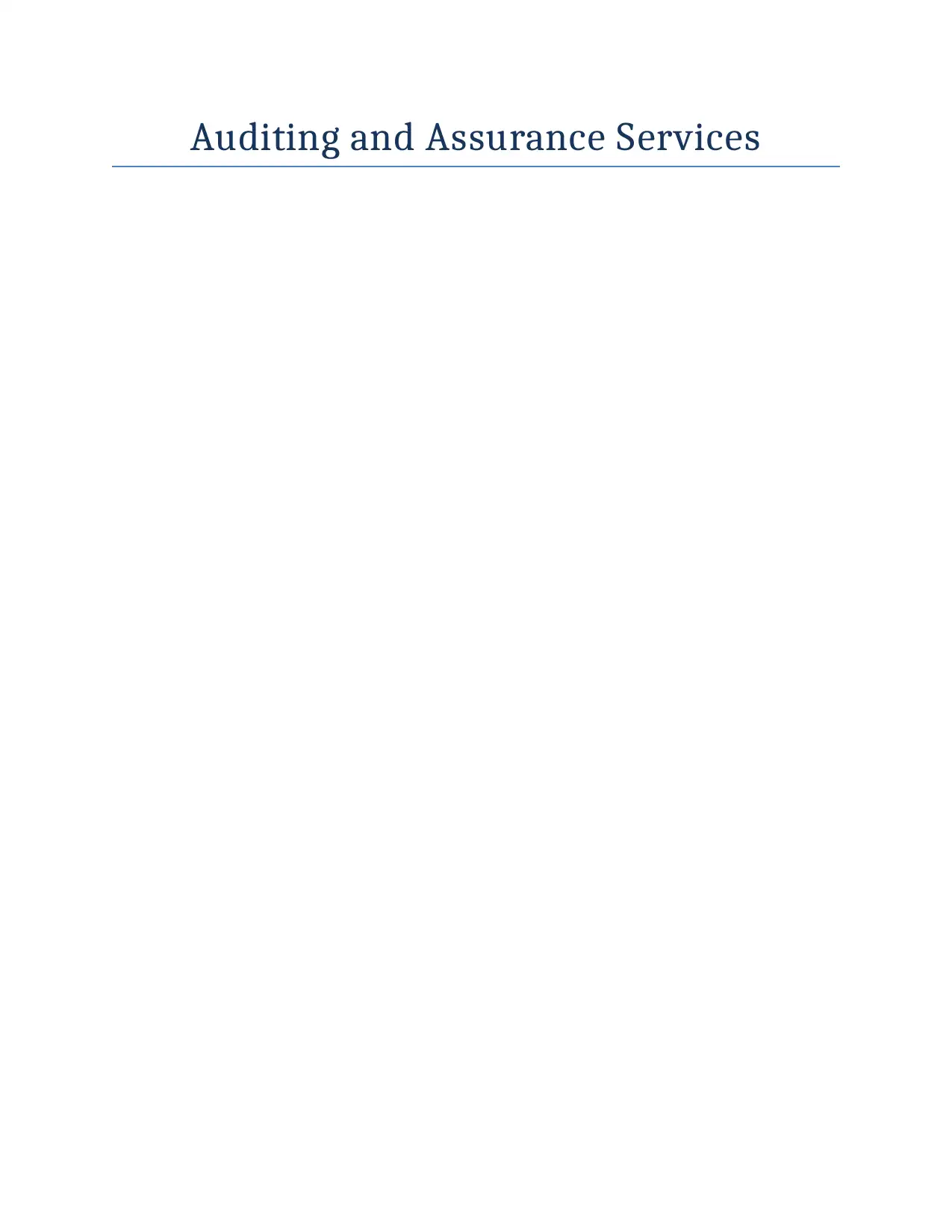
Auditing and Assurance Services
Paraphrase This Document
Need a fresh take? Get an instant paraphrase of this document with our AI Paraphraser

Table of Contents
Introduction......................................................................................................................................3
Question 1........................................................................................................................................3
Key assertions at risk with respect to inventory..........................................................................4
Substantive audit procedure in response to the identified risk....................................................5
Communication of the key audit matters in the Auditor’s Report...............................................7
Question 2........................................................................................................................................8
Key assertion at risk in relation to property, plant and equipment..............................................8
Substantive procedure in response to the identified risk.............................................................9
Communication of the key audit matters in the report of the auditor........................................10
Conclusion.....................................................................................................................................11
References......................................................................................................................................12
Introduction......................................................................................................................................3
Question 1........................................................................................................................................3
Key assertions at risk with respect to inventory..........................................................................4
Substantive audit procedure in response to the identified risk....................................................5
Communication of the key audit matters in the Auditor’s Report...............................................7
Question 2........................................................................................................................................8
Key assertion at risk in relation to property, plant and equipment..............................................8
Substantive procedure in response to the identified risk.............................................................9
Communication of the key audit matters in the report of the auditor........................................10
Conclusion.....................................................................................................................................11
References......................................................................................................................................12

INTRODUCTION
Auditing standards are made by the Auditing and Assurance Standard Board, which is an
independent committee of the government of Australia. At the time of performing the audit, it is
mandatory for the auditors to comply with the all relevant procedures prescribed in the auditing
standard (Louwers & et al. 2015). It gives the guidelines to the auditor for carrying out the audit
procedure, which enhances the transparency, reliability and relevance of the financial statement.
Inventory and the plant, property and equipment are considered as the main element of the
financial statement (Kellenberg, and Levinson, 2016). The present study revolves around the
auditing standard 506, which is related to the “Existence and the valuation of the inventory”.
Along with this, all the matter which impacts the decision of the auditor significantly must be
communicated by the auditor to directors, senior management and those charged with
governance. The relevant guidelines with respect to the communication of the key audit matters
are provided in the auditing standard 701, “communicating key audit matters in the independent
auditor’s report”.
QUESTION 1
The Australian auditing standard describes the requirement and the implementation and other
evaluating material with respect the to the responsibility of the auditor when he/she undertakes
any assignment related with the audit of the financial statement, other historical financial
information, or a complete set of financial statement (Beasley and et al. 2018). It is the
accountability of the auditor to ensure whether the financial statement is prepared according to
the generally accepted accounting principle, the existence of the internal control system and their
compliance, verification of the assets and liabilities, whether value stated in the financial
statement reflects the true and fair value (Wright, 2016).
Value of the inventory significantly impacts the financial statement of any entity. At the time of
performing an audit, the auditor must apply the Auditing standard 506 “Existence and valuation
of the Inventory”. This standard provides the auditor regarding obtaining the sufficient
appropriate audit evidence with respect to the valuation and existence of inventory in the
financial statement. the auditor is responsible for obtaining the sufficient and appropriate audit
Auditing standards are made by the Auditing and Assurance Standard Board, which is an
independent committee of the government of Australia. At the time of performing the audit, it is
mandatory for the auditors to comply with the all relevant procedures prescribed in the auditing
standard (Louwers & et al. 2015). It gives the guidelines to the auditor for carrying out the audit
procedure, which enhances the transparency, reliability and relevance of the financial statement.
Inventory and the plant, property and equipment are considered as the main element of the
financial statement (Kellenberg, and Levinson, 2016). The present study revolves around the
auditing standard 506, which is related to the “Existence and the valuation of the inventory”.
Along with this, all the matter which impacts the decision of the auditor significantly must be
communicated by the auditor to directors, senior management and those charged with
governance. The relevant guidelines with respect to the communication of the key audit matters
are provided in the auditing standard 701, “communicating key audit matters in the independent
auditor’s report”.
QUESTION 1
The Australian auditing standard describes the requirement and the implementation and other
evaluating material with respect the to the responsibility of the auditor when he/she undertakes
any assignment related with the audit of the financial statement, other historical financial
information, or a complete set of financial statement (Beasley and et al. 2018). It is the
accountability of the auditor to ensure whether the financial statement is prepared according to
the generally accepted accounting principle, the existence of the internal control system and their
compliance, verification of the assets and liabilities, whether value stated in the financial
statement reflects the true and fair value (Wright, 2016).
Value of the inventory significantly impacts the financial statement of any entity. At the time of
performing an audit, the auditor must apply the Auditing standard 506 “Existence and valuation
of the Inventory”. This standard provides the auditor regarding obtaining the sufficient
appropriate audit evidence with respect to the valuation and existence of inventory in the
financial statement. the auditor is responsible for obtaining the sufficient and appropriate audit
⊘ This is a preview!⊘
Do you want full access?
Subscribe today to unlock all pages.

Trusted by 1+ million students worldwide

evidence with respect to the valuation as well as the presence of the inventory and identifies
whether it reflect in the financial statement properly (Auditing and assurance standard Board,
2002).
In the given study, at the time of audit of the company named as Advanced Computer Solutions
Ltd, while assessing the risk of material misstatement and determine the appropriate response
with respect to the inventory, auditor becomes aware of the many issues.
Key assertions at risk with respect to inventory
Audit assertion refers as the claim or the representation made by the management of the
company regarding the responsibility of the preparation of the financial statement along with the
appropriateness of the several elements in the financial statement and the disclosure (Huo, and
Zhang, 2017). Subsequently, the auditor has to apply these assertions at the time of considering
the probable types of misstatement that may happen and also at the time designing and
performing appropriate audit procedures. With respect to this, the most important assertion
related to the present scenario is described below –
Presences of the inventory
The value of the inventory which is stated in the financial statement is actually held by the
company. There are chances of disposed of inventory without being recorded in the financial
statement or inventory may be stolen by some person.
Valuation
The year-end inventory may not be recorded in the actual fiscal year. In the given study there is a
significant difference in the inventory turnover ratio, which is based on the closing inventory.
This may be possible because the company wrongly record the transactions related to the
purchasing and selling of the inventory on the last day of the year. Further, due to the software
problem high level of return experienced by the company, there is the risk of how the
management accounts for the return of the inventory. Appropriate provisions are made by the
company or not. Inventory related with the other company may be recorded along with the own
inventory. Along with this, too old inventory or the scrapped inventory also not identified by the
company and carried along with the good stock of the company.
whether it reflect in the financial statement properly (Auditing and assurance standard Board,
2002).
In the given study, at the time of audit of the company named as Advanced Computer Solutions
Ltd, while assessing the risk of material misstatement and determine the appropriate response
with respect to the inventory, auditor becomes aware of the many issues.
Key assertions at risk with respect to inventory
Audit assertion refers as the claim or the representation made by the management of the
company regarding the responsibility of the preparation of the financial statement along with the
appropriateness of the several elements in the financial statement and the disclosure (Huo, and
Zhang, 2017). Subsequently, the auditor has to apply these assertions at the time of considering
the probable types of misstatement that may happen and also at the time designing and
performing appropriate audit procedures. With respect to this, the most important assertion
related to the present scenario is described below –
Presences of the inventory
The value of the inventory which is stated in the financial statement is actually held by the
company. There are chances of disposed of inventory without being recorded in the financial
statement or inventory may be stolen by some person.
Valuation
The year-end inventory may not be recorded in the actual fiscal year. In the given study there is a
significant difference in the inventory turnover ratio, which is based on the closing inventory.
This may be possible because the company wrongly record the transactions related to the
purchasing and selling of the inventory on the last day of the year. Further, due to the software
problem high level of return experienced by the company, there is the risk of how the
management accounts for the return of the inventory. Appropriate provisions are made by the
company or not. Inventory related with the other company may be recorded along with the own
inventory. Along with this, too old inventory or the scrapped inventory also not identified by the
company and carried along with the good stock of the company.
Paraphrase This Document
Need a fresh take? Get an instant paraphrase of this document with our AI Paraphraser
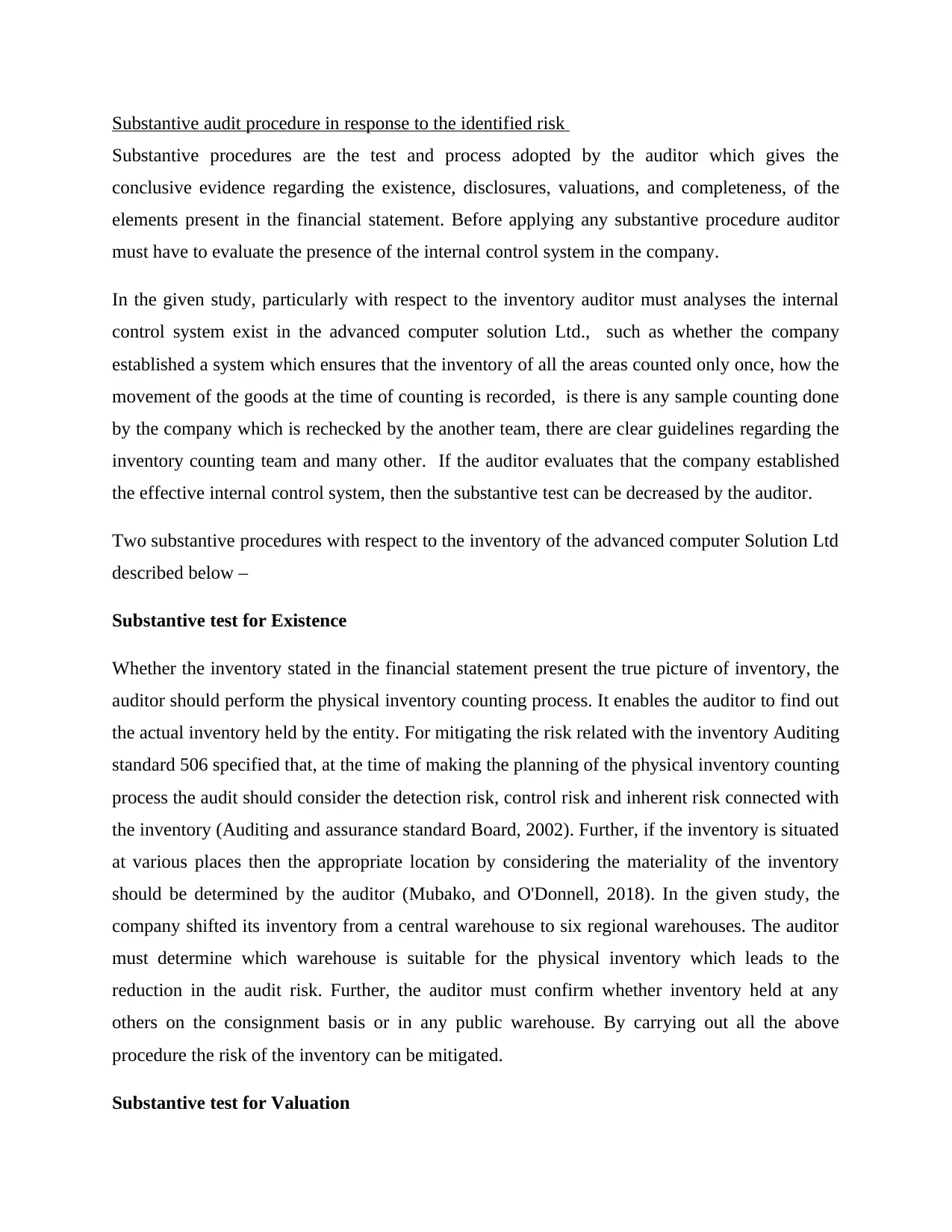
Substantive audit procedure in response to the identified risk
Substantive procedures are the test and process adopted by the auditor which gives the
conclusive evidence regarding the existence, disclosures, valuations, and completeness, of the
elements present in the financial statement. Before applying any substantive procedure auditor
must have to evaluate the presence of the internal control system in the company.
In the given study, particularly with respect to the inventory auditor must analyses the internal
control system exist in the advanced computer solution Ltd., such as whether the company
established a system which ensures that the inventory of all the areas counted only once, how the
movement of the goods at the time of counting is recorded, is there is any sample counting done
by the company which is rechecked by the another team, there are clear guidelines regarding the
inventory counting team and many other. If the auditor evaluates that the company established
the effective internal control system, then the substantive test can be decreased by the auditor.
Two substantive procedures with respect to the inventory of the advanced computer Solution Ltd
described below –
Substantive test for Existence
Whether the inventory stated in the financial statement present the true picture of inventory, the
auditor should perform the physical inventory counting process. It enables the auditor to find out
the actual inventory held by the entity. For mitigating the risk related with the inventory Auditing
standard 506 specified that, at the time of making the planning of the physical inventory counting
process the audit should consider the detection risk, control risk and inherent risk connected with
the inventory (Auditing and assurance standard Board, 2002). Further, if the inventory is situated
at various places then the appropriate location by considering the materiality of the inventory
should be determined by the auditor (Mubako, and O'Donnell, 2018). In the given study, the
company shifted its inventory from a central warehouse to six regional warehouses. The auditor
must determine which warehouse is suitable for the physical inventory which leads to the
reduction in the audit risk. Further, the auditor must confirm whether inventory held at any
others on the consignment basis or in any public warehouse. By carrying out all the above
procedure the risk of the inventory can be mitigated.
Substantive test for Valuation
Substantive procedures are the test and process adopted by the auditor which gives the
conclusive evidence regarding the existence, disclosures, valuations, and completeness, of the
elements present in the financial statement. Before applying any substantive procedure auditor
must have to evaluate the presence of the internal control system in the company.
In the given study, particularly with respect to the inventory auditor must analyses the internal
control system exist in the advanced computer solution Ltd., such as whether the company
established a system which ensures that the inventory of all the areas counted only once, how the
movement of the goods at the time of counting is recorded, is there is any sample counting done
by the company which is rechecked by the another team, there are clear guidelines regarding the
inventory counting team and many other. If the auditor evaluates that the company established
the effective internal control system, then the substantive test can be decreased by the auditor.
Two substantive procedures with respect to the inventory of the advanced computer Solution Ltd
described below –
Substantive test for Existence
Whether the inventory stated in the financial statement present the true picture of inventory, the
auditor should perform the physical inventory counting process. It enables the auditor to find out
the actual inventory held by the entity. For mitigating the risk related with the inventory Auditing
standard 506 specified that, at the time of making the planning of the physical inventory counting
process the audit should consider the detection risk, control risk and inherent risk connected with
the inventory (Auditing and assurance standard Board, 2002). Further, if the inventory is situated
at various places then the appropriate location by considering the materiality of the inventory
should be determined by the auditor (Mubako, and O'Donnell, 2018). In the given study, the
company shifted its inventory from a central warehouse to six regional warehouses. The auditor
must determine which warehouse is suitable for the physical inventory which leads to the
reduction in the audit risk. Further, the auditor must confirm whether inventory held at any
others on the consignment basis or in any public warehouse. By carrying out all the above
procedure the risk of the inventory can be mitigated.
Substantive test for Valuation
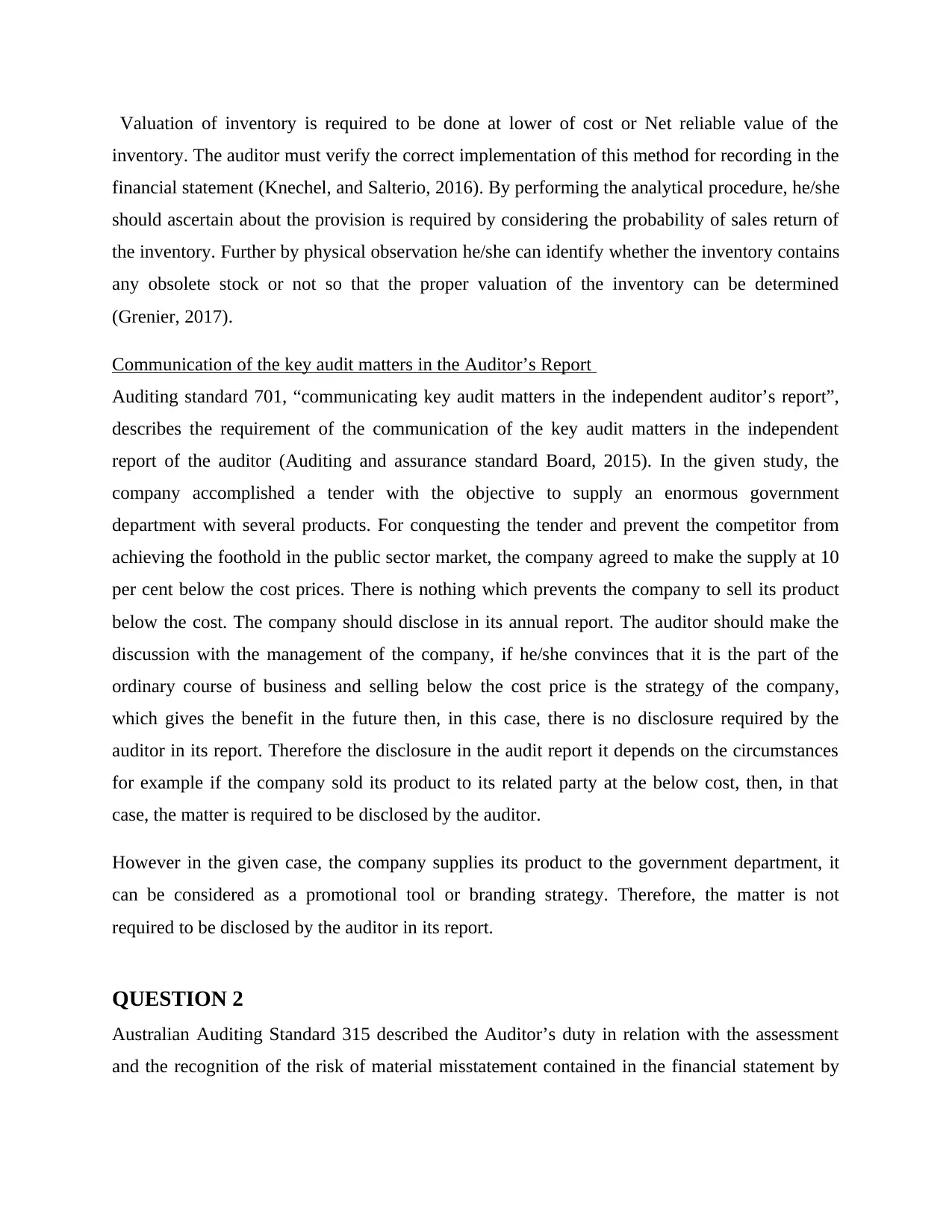
Valuation of inventory is required to be done at lower of cost or Net reliable value of the
inventory. The auditor must verify the correct implementation of this method for recording in the
financial statement (Knechel, and Salterio, 2016). By performing the analytical procedure, he/she
should ascertain about the provision is required by considering the probability of sales return of
the inventory. Further by physical observation he/she can identify whether the inventory contains
any obsolete stock or not so that the proper valuation of the inventory can be determined
(Grenier, 2017).
Communication of the key audit matters in the Auditor’s Report
Auditing standard 701, “communicating key audit matters in the independent auditor’s report”,
describes the requirement of the communication of the key audit matters in the independent
report of the auditor (Auditing and assurance standard Board, 2015). In the given study, the
company accomplished a tender with the objective to supply an enormous government
department with several products. For conquesting the tender and prevent the competitor from
achieving the foothold in the public sector market, the company agreed to make the supply at 10
per cent below the cost prices. There is nothing which prevents the company to sell its product
below the cost. The company should disclose in its annual report. The auditor should make the
discussion with the management of the company, if he/she convinces that it is the part of the
ordinary course of business and selling below the cost price is the strategy of the company,
which gives the benefit in the future then, in this case, there is no disclosure required by the
auditor in its report. Therefore the disclosure in the audit report it depends on the circumstances
for example if the company sold its product to its related party at the below cost, then, in that
case, the matter is required to be disclosed by the auditor.
However in the given case, the company supplies its product to the government department, it
can be considered as a promotional tool or branding strategy. Therefore, the matter is not
required to be disclosed by the auditor in its report.
QUESTION 2
Australian Auditing Standard 315 described the Auditor’s duty in relation with the assessment
and the recognition of the risk of material misstatement contained in the financial statement by
inventory. The auditor must verify the correct implementation of this method for recording in the
financial statement (Knechel, and Salterio, 2016). By performing the analytical procedure, he/she
should ascertain about the provision is required by considering the probability of sales return of
the inventory. Further by physical observation he/she can identify whether the inventory contains
any obsolete stock or not so that the proper valuation of the inventory can be determined
(Grenier, 2017).
Communication of the key audit matters in the Auditor’s Report
Auditing standard 701, “communicating key audit matters in the independent auditor’s report”,
describes the requirement of the communication of the key audit matters in the independent
report of the auditor (Auditing and assurance standard Board, 2015). In the given study, the
company accomplished a tender with the objective to supply an enormous government
department with several products. For conquesting the tender and prevent the competitor from
achieving the foothold in the public sector market, the company agreed to make the supply at 10
per cent below the cost prices. There is nothing which prevents the company to sell its product
below the cost. The company should disclose in its annual report. The auditor should make the
discussion with the management of the company, if he/she convinces that it is the part of the
ordinary course of business and selling below the cost price is the strategy of the company,
which gives the benefit in the future then, in this case, there is no disclosure required by the
auditor in its report. Therefore the disclosure in the audit report it depends on the circumstances
for example if the company sold its product to its related party at the below cost, then, in that
case, the matter is required to be disclosed by the auditor.
However in the given case, the company supplies its product to the government department, it
can be considered as a promotional tool or branding strategy. Therefore, the matter is not
required to be disclosed by the auditor in its report.
QUESTION 2
Australian Auditing Standard 315 described the Auditor’s duty in relation with the assessment
and the recognition of the risk of material misstatement contained in the financial statement by
⊘ This is a preview!⊘
Do you want full access?
Subscribe today to unlock all pages.

Trusted by 1+ million students worldwide

understanding the environment as well as the internal control established in the company (Simon,
Smith, and Zimbelman, 2018).
Further, the auditing standard 240 specified the responsibility of the auditor with respect to the
material misstatement due to the fraud or error stated in the financial statement (Mock,
Srivastava, and Wright, 2017).
Key assertion at risk in relation to property, plant and equipment
Accuracy
All the amount and data connected with the recorded transactions and the events have been
systematically recorded in the financial statement. Further, the disclosures have been
appropriately described and measured (Brasel & et al. 2016). In the given study, it is stated that
the management letter from the audit of the previous year shows that there are some issues
regarding making the distinction between the capital and revenue expenditure. The items which
should be capitalized are stated in the income and expenditure account, and some item was
capitalized when they included in the income statement. In this case, risk related to the material
misstatement in the property, plant and equipment account could be lead to the inaccurate figures
in the financial statement as well as in income statement. Further, it will also make an impact on
the depreciation expenses, which is deductible expense according to the income tax act. In case
the expense which is required to be charged from the income and expense account are capitalized
in the asset that same will assist to the presentation of the overstated profit of the company.
Valuation
All the amount and data related to the recorded transaction must be valued correctly. The value
of the Property, plant and machinery account should be reflected after charging the appropriate
rate of depreciation (Lim, and Foo, 2017). There should be uniformity in the depreciation rate. In
other words, it can be said the rate of depreciation should be the same for the same categories of
the asset, by which the consistency can be maintained. In the given study, the company names as
Green Machine Ltd. uses the several depreciation rates within the categories. There is the risk of
material misstatement that the charging lower rate of depreciation may lead to a higher valuation
of the assets. Along with this it also makes an impact on the profit and loss account by enhancing
the profit.
Smith, and Zimbelman, 2018).
Further, the auditing standard 240 specified the responsibility of the auditor with respect to the
material misstatement due to the fraud or error stated in the financial statement (Mock,
Srivastava, and Wright, 2017).
Key assertion at risk in relation to property, plant and equipment
Accuracy
All the amount and data connected with the recorded transactions and the events have been
systematically recorded in the financial statement. Further, the disclosures have been
appropriately described and measured (Brasel & et al. 2016). In the given study, it is stated that
the management letter from the audit of the previous year shows that there are some issues
regarding making the distinction between the capital and revenue expenditure. The items which
should be capitalized are stated in the income and expenditure account, and some item was
capitalized when they included in the income statement. In this case, risk related to the material
misstatement in the property, plant and equipment account could be lead to the inaccurate figures
in the financial statement as well as in income statement. Further, it will also make an impact on
the depreciation expenses, which is deductible expense according to the income tax act. In case
the expense which is required to be charged from the income and expense account are capitalized
in the asset that same will assist to the presentation of the overstated profit of the company.
Valuation
All the amount and data related to the recorded transaction must be valued correctly. The value
of the Property, plant and machinery account should be reflected after charging the appropriate
rate of depreciation (Lim, and Foo, 2017). There should be uniformity in the depreciation rate. In
other words, it can be said the rate of depreciation should be the same for the same categories of
the asset, by which the consistency can be maintained. In the given study, the company names as
Green Machine Ltd. uses the several depreciation rates within the categories. There is the risk of
material misstatement that the charging lower rate of depreciation may lead to a higher valuation
of the assets. Along with this it also makes an impact on the profit and loss account by enhancing
the profit.
Paraphrase This Document
Need a fresh take? Get an instant paraphrase of this document with our AI Paraphraser
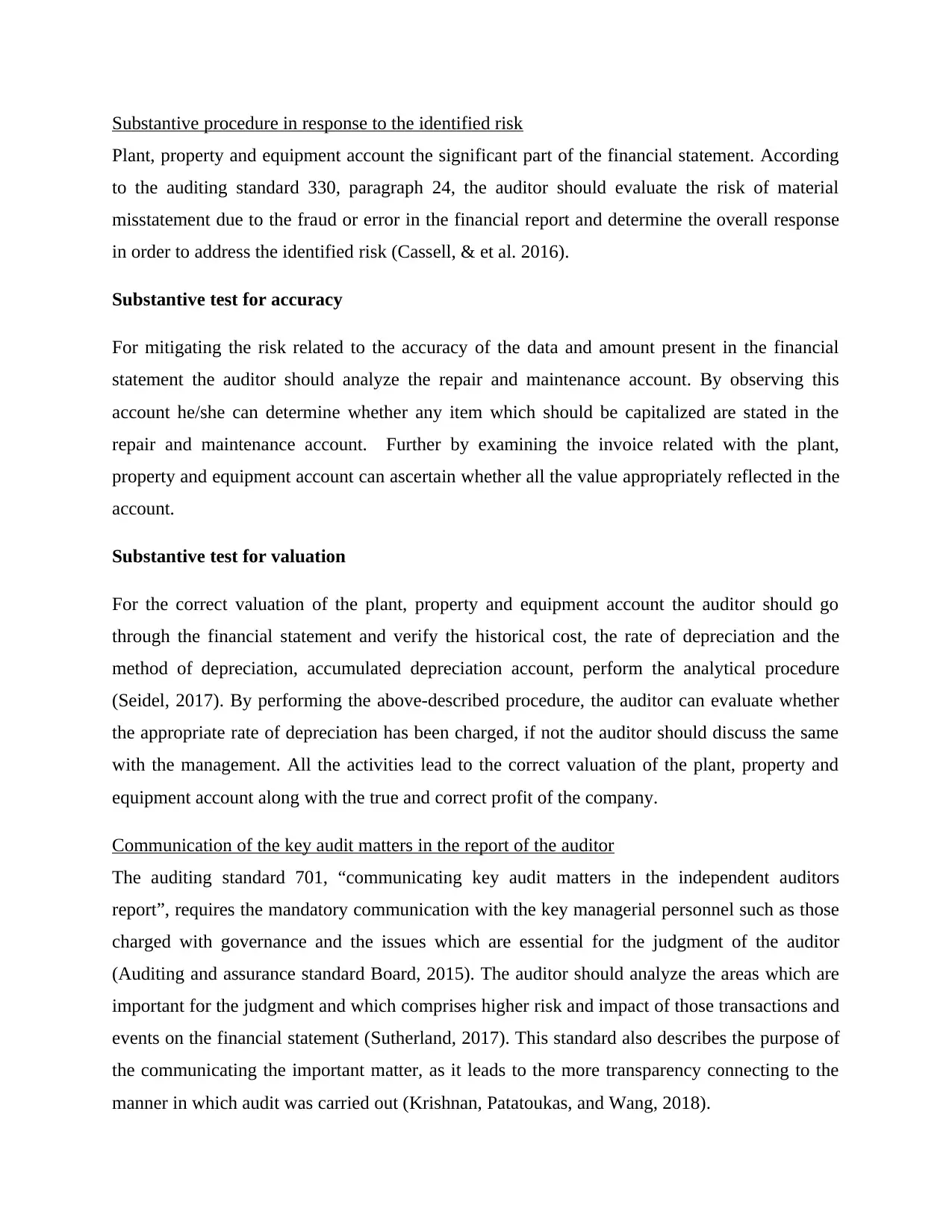
Substantive procedure in response to the identified risk
Plant, property and equipment account the significant part of the financial statement. According
to the auditing standard 330, paragraph 24, the auditor should evaluate the risk of material
misstatement due to the fraud or error in the financial report and determine the overall response
in order to address the identified risk (Cassell, & et al. 2016).
Substantive test for accuracy
For mitigating the risk related to the accuracy of the data and amount present in the financial
statement the auditor should analyze the repair and maintenance account. By observing this
account he/she can determine whether any item which should be capitalized are stated in the
repair and maintenance account. Further by examining the invoice related with the plant,
property and equipment account can ascertain whether all the value appropriately reflected in the
account.
Substantive test for valuation
For the correct valuation of the plant, property and equipment account the auditor should go
through the financial statement and verify the historical cost, the rate of depreciation and the
method of depreciation, accumulated depreciation account, perform the analytical procedure
(Seidel, 2017). By performing the above-described procedure, the auditor can evaluate whether
the appropriate rate of depreciation has been charged, if not the auditor should discuss the same
with the management. All the activities lead to the correct valuation of the plant, property and
equipment account along with the true and correct profit of the company.
Communication of the key audit matters in the report of the auditor
The auditing standard 701, “communicating key audit matters in the independent auditors
report”, requires the mandatory communication with the key managerial personnel such as those
charged with governance and the issues which are essential for the judgment of the auditor
(Auditing and assurance standard Board, 2015). The auditor should analyze the areas which are
important for the judgment and which comprises higher risk and impact of those transactions and
events on the financial statement (Sutherland, 2017). This standard also describes the purpose of
the communicating the important matter, as it leads to the more transparency connecting to the
manner in which audit was carried out (Krishnan, Patatoukas, and Wang, 2018).
Plant, property and equipment account the significant part of the financial statement. According
to the auditing standard 330, paragraph 24, the auditor should evaluate the risk of material
misstatement due to the fraud or error in the financial report and determine the overall response
in order to address the identified risk (Cassell, & et al. 2016).
Substantive test for accuracy
For mitigating the risk related to the accuracy of the data and amount present in the financial
statement the auditor should analyze the repair and maintenance account. By observing this
account he/she can determine whether any item which should be capitalized are stated in the
repair and maintenance account. Further by examining the invoice related with the plant,
property and equipment account can ascertain whether all the value appropriately reflected in the
account.
Substantive test for valuation
For the correct valuation of the plant, property and equipment account the auditor should go
through the financial statement and verify the historical cost, the rate of depreciation and the
method of depreciation, accumulated depreciation account, perform the analytical procedure
(Seidel, 2017). By performing the above-described procedure, the auditor can evaluate whether
the appropriate rate of depreciation has been charged, if not the auditor should discuss the same
with the management. All the activities lead to the correct valuation of the plant, property and
equipment account along with the true and correct profit of the company.
Communication of the key audit matters in the report of the auditor
The auditing standard 701, “communicating key audit matters in the independent auditors
report”, requires the mandatory communication with the key managerial personnel such as those
charged with governance and the issues which are essential for the judgment of the auditor
(Auditing and assurance standard Board, 2015). The auditor should analyze the areas which are
important for the judgment and which comprises higher risk and impact of those transactions and
events on the financial statement (Sutherland, 2017). This standard also describes the purpose of
the communicating the important matter, as it leads to the more transparency connecting to the
manner in which audit was carried out (Krishnan, Patatoukas, and Wang, 2018).
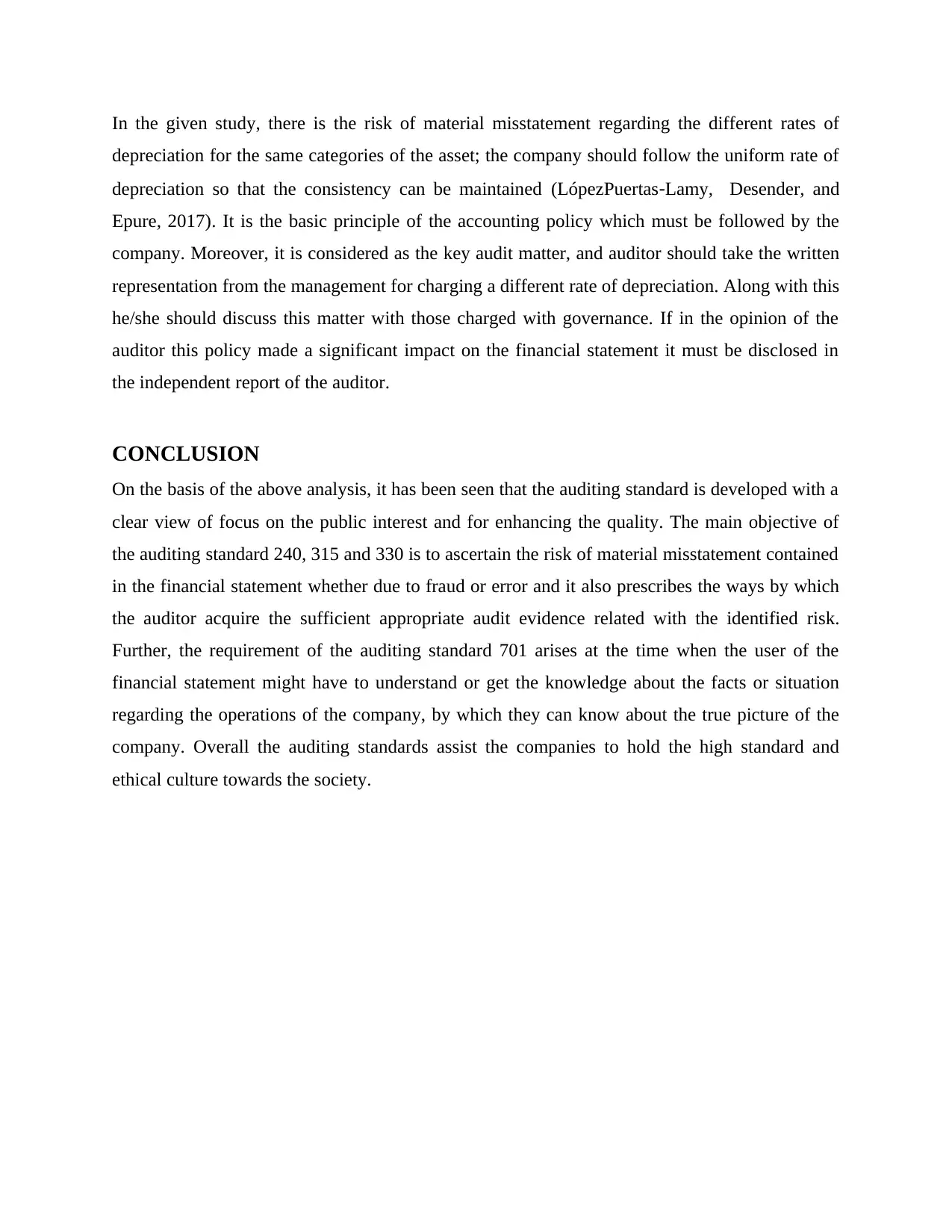
In the given study, there is the risk of material misstatement regarding the different rates of
depreciation for the same categories of the asset; the company should follow the uniform rate of
depreciation so that the consistency can be maintained (LópezPuertas‐Lamy, Desender, and
Epure, 2017). It is the basic principle of the accounting policy which must be followed by the
company. Moreover, it is considered as the key audit matter, and auditor should take the written
representation from the management for charging a different rate of depreciation. Along with this
he/she should discuss this matter with those charged with governance. If in the opinion of the
auditor this policy made a significant impact on the financial statement it must be disclosed in
the independent report of the auditor.
CONCLUSION
On the basis of the above analysis, it has been seen that the auditing standard is developed with a
clear view of focus on the public interest and for enhancing the quality. The main objective of
the auditing standard 240, 315 and 330 is to ascertain the risk of material misstatement contained
in the financial statement whether due to fraud or error and it also prescribes the ways by which
the auditor acquire the sufficient appropriate audit evidence related with the identified risk.
Further, the requirement of the auditing standard 701 arises at the time when the user of the
financial statement might have to understand or get the knowledge about the facts or situation
regarding the operations of the company, by which they can know about the true picture of the
company. Overall the auditing standards assist the companies to hold the high standard and
ethical culture towards the society.
depreciation for the same categories of the asset; the company should follow the uniform rate of
depreciation so that the consistency can be maintained (LópezPuertas‐Lamy, Desender, and
Epure, 2017). It is the basic principle of the accounting policy which must be followed by the
company. Moreover, it is considered as the key audit matter, and auditor should take the written
representation from the management for charging a different rate of depreciation. Along with this
he/she should discuss this matter with those charged with governance. If in the opinion of the
auditor this policy made a significant impact on the financial statement it must be disclosed in
the independent report of the auditor.
CONCLUSION
On the basis of the above analysis, it has been seen that the auditing standard is developed with a
clear view of focus on the public interest and for enhancing the quality. The main objective of
the auditing standard 240, 315 and 330 is to ascertain the risk of material misstatement contained
in the financial statement whether due to fraud or error and it also prescribes the ways by which
the auditor acquire the sufficient appropriate audit evidence related with the identified risk.
Further, the requirement of the auditing standard 701 arises at the time when the user of the
financial statement might have to understand or get the knowledge about the facts or situation
regarding the operations of the company, by which they can know about the true picture of the
company. Overall the auditing standards assist the companies to hold the high standard and
ethical culture towards the society.
⊘ This is a preview!⊘
Do you want full access?
Subscribe today to unlock all pages.

Trusted by 1+ million students worldwide
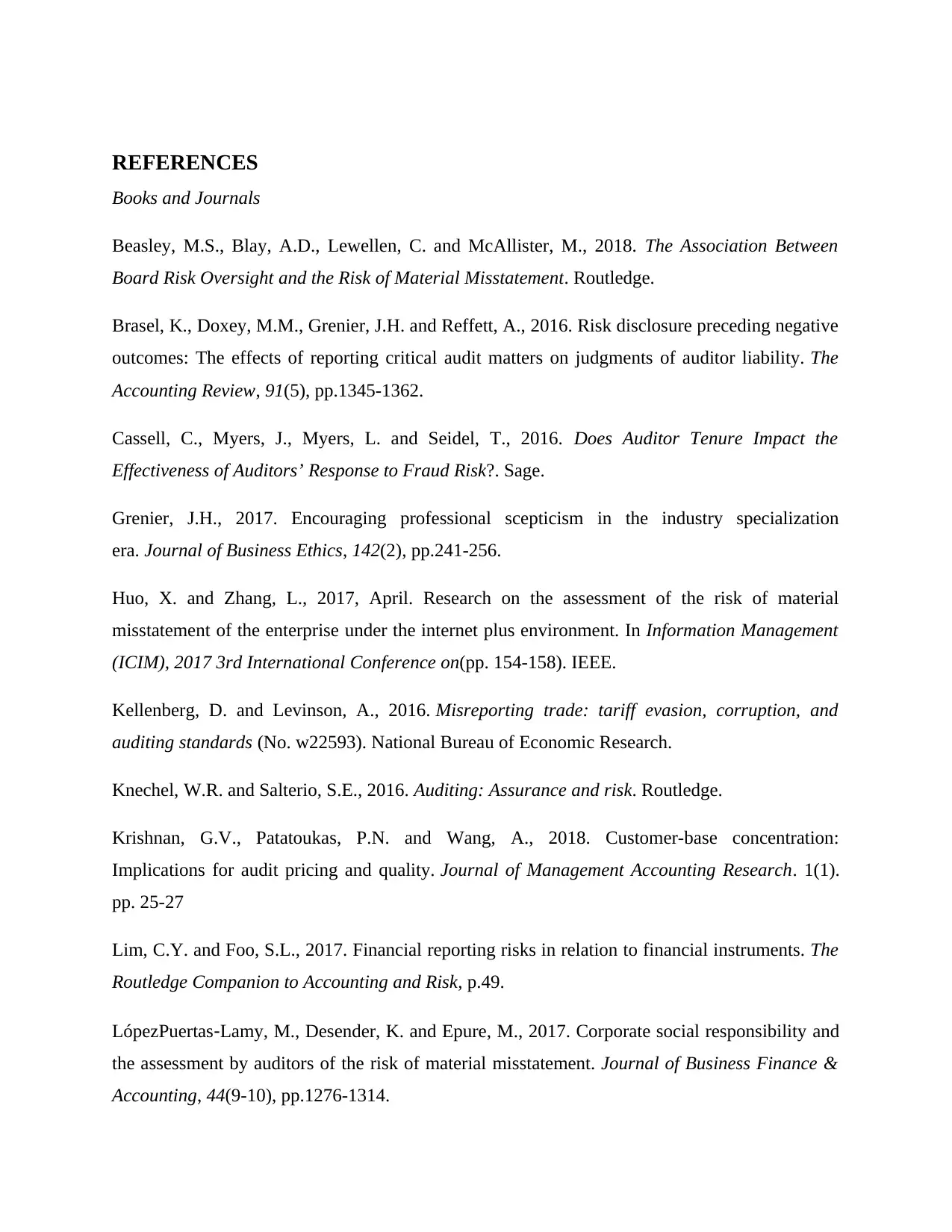
REFERENCES
Books and Journals
Beasley, M.S., Blay, A.D., Lewellen, C. and McAllister, M., 2018. The Association Between
Board Risk Oversight and the Risk of Material Misstatement. Routledge.
Brasel, K., Doxey, M.M., Grenier, J.H. and Reffett, A., 2016. Risk disclosure preceding negative
outcomes: The effects of reporting critical audit matters on judgments of auditor liability. The
Accounting Review, 91(5), pp.1345-1362.
Cassell, C., Myers, J., Myers, L. and Seidel, T., 2016. Does Auditor Tenure Impact the
Effectiveness of Auditors’ Response to Fraud Risk?. Sage.
Grenier, J.H., 2017. Encouraging professional scepticism in the industry specialization
era. Journal of Business Ethics, 142(2), pp.241-256.
Huo, X. and Zhang, L., 2017, April. Research on the assessment of the risk of material
misstatement of the enterprise under the internet plus environment. In Information Management
(ICIM), 2017 3rd International Conference on(pp. 154-158). IEEE.
Kellenberg, D. and Levinson, A., 2016. Misreporting trade: tariff evasion, corruption, and
auditing standards (No. w22593). National Bureau of Economic Research.
Knechel, W.R. and Salterio, S.E., 2016. Auditing: Assurance and risk. Routledge.
Krishnan, G.V., Patatoukas, P.N. and Wang, A., 2018. Customer-base concentration:
Implications for audit pricing and quality. Journal of Management Accounting Research. 1(1).
pp. 25-27
Lim, C.Y. and Foo, S.L., 2017. Financial reporting risks in relation to financial instruments. The
Routledge Companion to Accounting and Risk, p.49.
LópezPuertas‐Lamy, M., Desender, K. and Epure, M., 2017. Corporate social responsibility and
the assessment by auditors of the risk of material misstatement. Journal of Business Finance &
Accounting, 44(9-10), pp.1276-1314.
Books and Journals
Beasley, M.S., Blay, A.D., Lewellen, C. and McAllister, M., 2018. The Association Between
Board Risk Oversight and the Risk of Material Misstatement. Routledge.
Brasel, K., Doxey, M.M., Grenier, J.H. and Reffett, A., 2016. Risk disclosure preceding negative
outcomes: The effects of reporting critical audit matters on judgments of auditor liability. The
Accounting Review, 91(5), pp.1345-1362.
Cassell, C., Myers, J., Myers, L. and Seidel, T., 2016. Does Auditor Tenure Impact the
Effectiveness of Auditors’ Response to Fraud Risk?. Sage.
Grenier, J.H., 2017. Encouraging professional scepticism in the industry specialization
era. Journal of Business Ethics, 142(2), pp.241-256.
Huo, X. and Zhang, L., 2017, April. Research on the assessment of the risk of material
misstatement of the enterprise under the internet plus environment. In Information Management
(ICIM), 2017 3rd International Conference on(pp. 154-158). IEEE.
Kellenberg, D. and Levinson, A., 2016. Misreporting trade: tariff evasion, corruption, and
auditing standards (No. w22593). National Bureau of Economic Research.
Knechel, W.R. and Salterio, S.E., 2016. Auditing: Assurance and risk. Routledge.
Krishnan, G.V., Patatoukas, P.N. and Wang, A., 2018. Customer-base concentration:
Implications for audit pricing and quality. Journal of Management Accounting Research. 1(1).
pp. 25-27
Lim, C.Y. and Foo, S.L., 2017. Financial reporting risks in relation to financial instruments. The
Routledge Companion to Accounting and Risk, p.49.
LópezPuertas‐Lamy, M., Desender, K. and Epure, M., 2017. Corporate social responsibility and
the assessment by auditors of the risk of material misstatement. Journal of Business Finance &
Accounting, 44(9-10), pp.1276-1314.
Paraphrase This Document
Need a fresh take? Get an instant paraphrase of this document with our AI Paraphraser

Louwers, T.J., Ramsay, R.J., Sinason, D.H., Strawser, J.R. and Thibodeau, J.C., 2015. Auditing
& assurance services. McGraw-Hill Education.
Mock, T.J., Srivastava, R.P. and Wright, A.M., 2017. Fraud risk assessment using the fraud risk
model as a decision aid. Journal of emerging technologies in accounting, 14(1), pp.37-56.
Mubako, G. and O'Donnell, E., 2018. Effect of fraud risk assessments on auditor scepticism:
Unintended consequences on evidence evaluation. International Journal of Auditing, 22(1),
pp.55-64.
Seidel, T.A., 2017. Auditors’ Response to Assessments of High Control Risk: Further
Insights. Contemporary Accounting Research, 34(3), pp.1340-1377.
Simon, C.A., Smith, J.L. and Zimbelman, M.F., 2018. The Influence of Judgment
Decomposition on Auditors' Fraud Risk Assessments: Some Trade-Offs. The Accounting
Review, 93(5), pp.273-291.
Sutherland, D.W., 2017. Independent audit report. Newsmonth, 37(3), p.19.
Wright, W.F., 2016. Client business models, process business risks and the risk of material
misstatement of revenue. Accounting, Organizations and Society, 48, pp.43-55.
Online
Auditing and assurance standard Board, 2015. ASA 701 Communicating Key Audit Matters in
the Independent Auditor’s Report [Online]. Available through
<https://www.auasb.gov.au/admin/file/content102/c3/ASA_701_Explanatory_Statement_2015.p
df> [Assessed on 17 January 2019]
Auditing and assurance standard Board, 2002. ASA 506 Existence and Valuation of Inventory
[Online]. Available through <https://www.auasb.gov.au/admin/file/content102/c3/AUS506_07-
02.pdf> [Assessed on 17 January 2019]
& assurance services. McGraw-Hill Education.
Mock, T.J., Srivastava, R.P. and Wright, A.M., 2017. Fraud risk assessment using the fraud risk
model as a decision aid. Journal of emerging technologies in accounting, 14(1), pp.37-56.
Mubako, G. and O'Donnell, E., 2018. Effect of fraud risk assessments on auditor scepticism:
Unintended consequences on evidence evaluation. International Journal of Auditing, 22(1),
pp.55-64.
Seidel, T.A., 2017. Auditors’ Response to Assessments of High Control Risk: Further
Insights. Contemporary Accounting Research, 34(3), pp.1340-1377.
Simon, C.A., Smith, J.L. and Zimbelman, M.F., 2018. The Influence of Judgment
Decomposition on Auditors' Fraud Risk Assessments: Some Trade-Offs. The Accounting
Review, 93(5), pp.273-291.
Sutherland, D.W., 2017. Independent audit report. Newsmonth, 37(3), p.19.
Wright, W.F., 2016. Client business models, process business risks and the risk of material
misstatement of revenue. Accounting, Organizations and Society, 48, pp.43-55.
Online
Auditing and assurance standard Board, 2015. ASA 701 Communicating Key Audit Matters in
the Independent Auditor’s Report [Online]. Available through
<https://www.auasb.gov.au/admin/file/content102/c3/ASA_701_Explanatory_Statement_2015.p
df> [Assessed on 17 January 2019]
Auditing and assurance standard Board, 2002. ASA 506 Existence and Valuation of Inventory
[Online]. Available through <https://www.auasb.gov.au/admin/file/content102/c3/AUS506_07-
02.pdf> [Assessed on 17 January 2019]

⊘ This is a preview!⊘
Do you want full access?
Subscribe today to unlock all pages.

Trusted by 1+ million students worldwide
1 out of 12
Related Documents
Your All-in-One AI-Powered Toolkit for Academic Success.
+13062052269
info@desklib.com
Available 24*7 on WhatsApp / Email
![[object Object]](/_next/static/media/star-bottom.7253800d.svg)
Unlock your academic potential
Copyright © 2020–2025 A2Z Services. All Rights Reserved. Developed and managed by ZUCOL.





